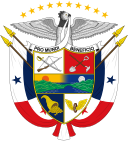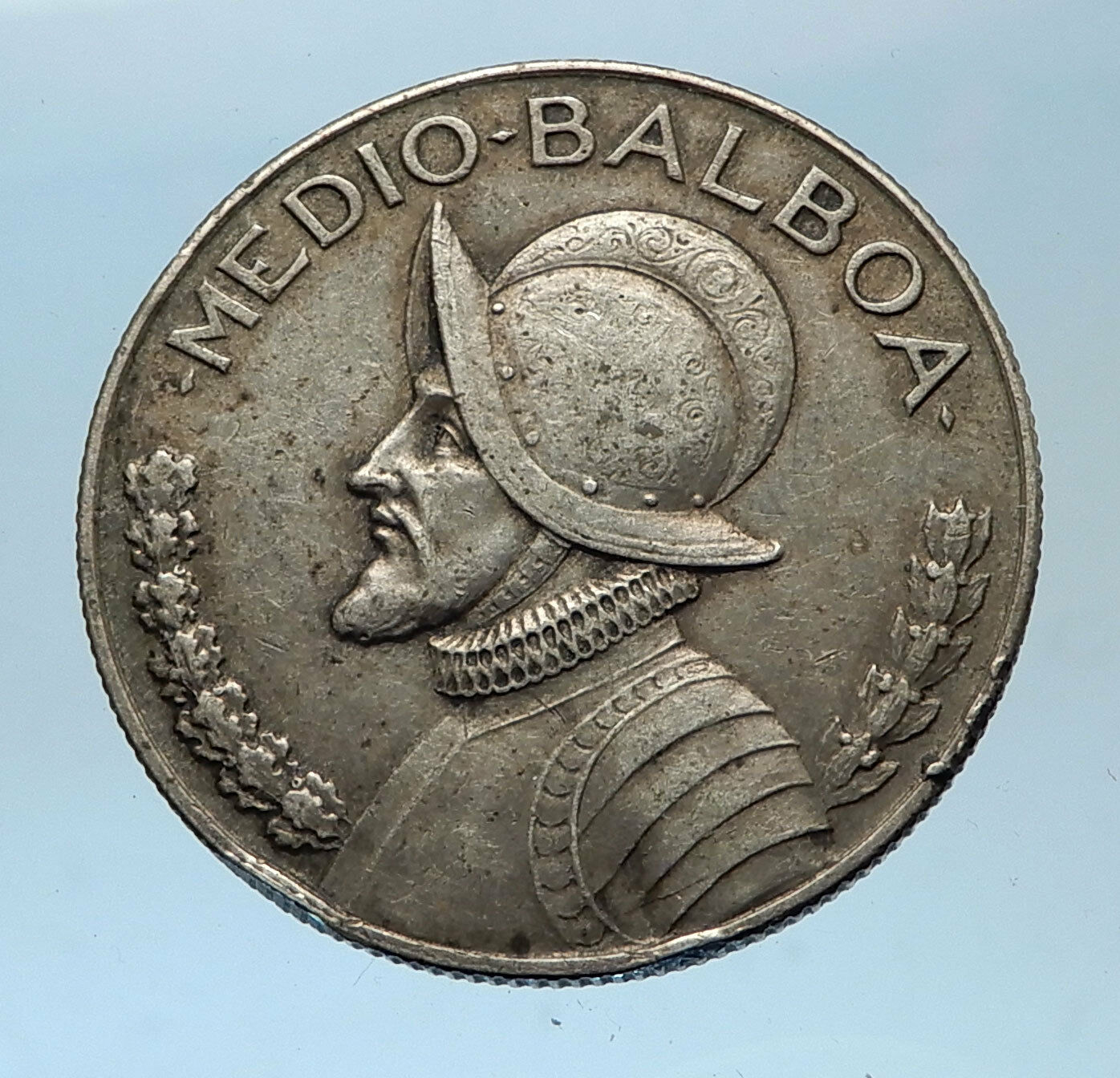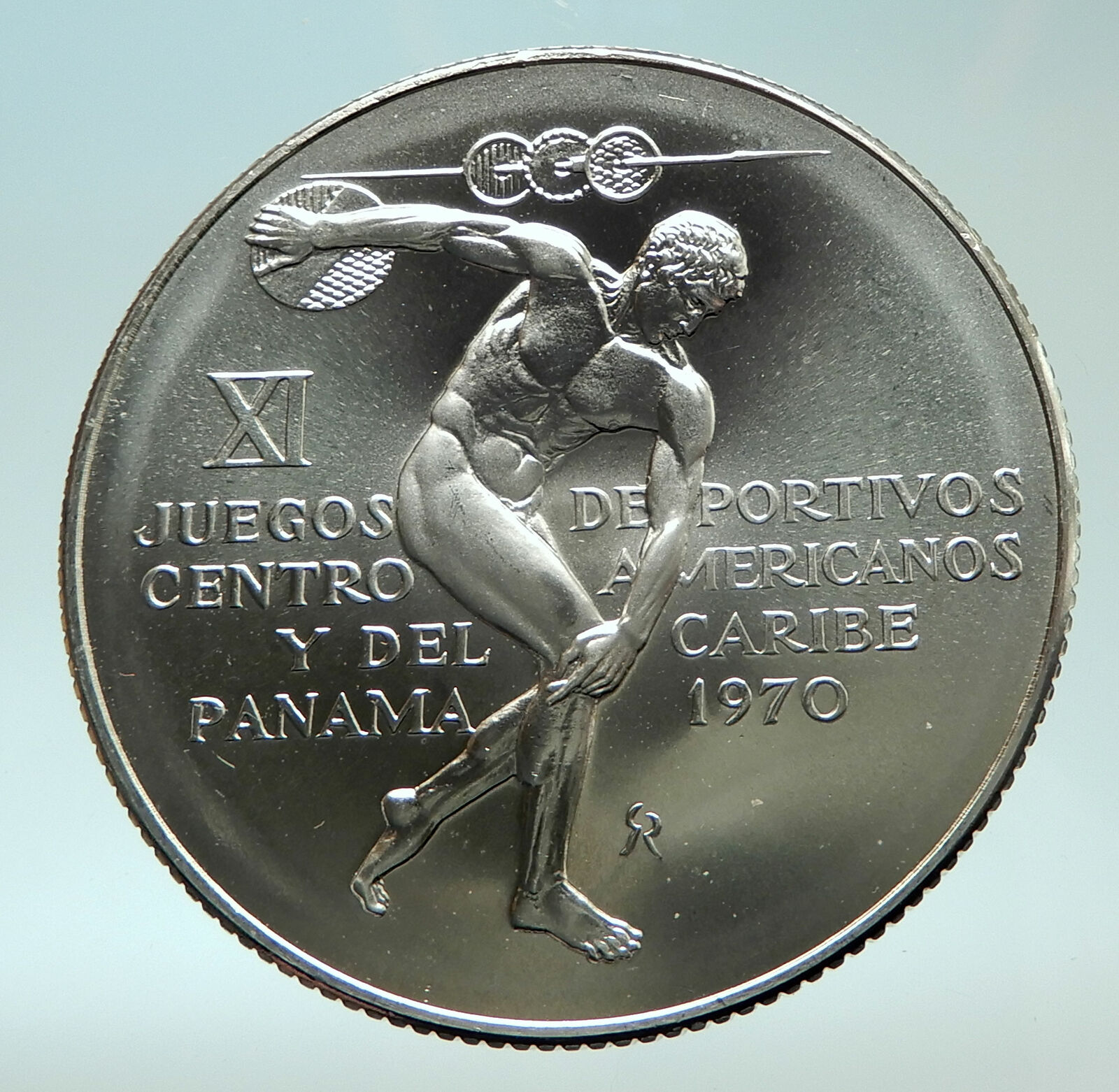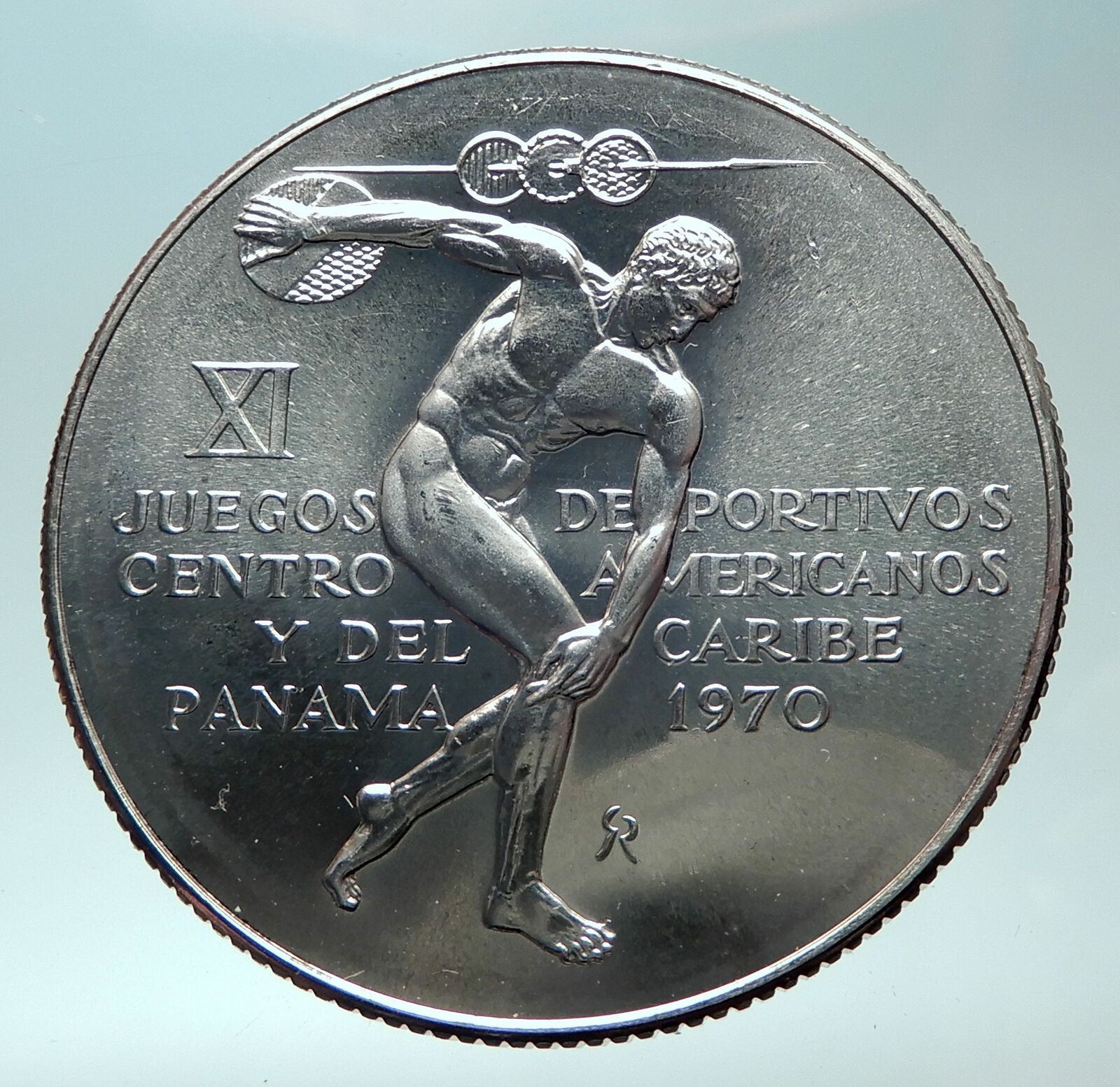|
Panama – 11th Central American and Caribbean Games Commemorative issue
1970 Silver 5 Balboas 38mm (36.14 grams) 0.925 Silver (1.0617 oz. ASW)
Reference: KM# 28
XI JUEGOS DEPORTIVOS CENTRO AMERICANOS Y DEL CARIBE PANAMA 1970 around discus thrower (emulating Myron’s Discobolus).
REPUBLICA DE PANAMA LEY 0.925 5 BALBOAS around national coat-of-arms with 5 stars above it.
The 11th Central American and Caribbean Games were held in Panama City, the capital of Panama from February 28 to March 13, 1970. These games featured 21 participating nations and a total number of 2,095 athletes.
You are bidding on the exact item pictured, provided with a Certificate of Authenticity and Lifetime Guarantee of Authenticity.
The discus throw is a track and field event in which an athlete throws a heavy disc-called a discus-in an attempt to mark a farther distance than their competitors. It is an ancient sport, as demonstrated by the fifth-century-BC Myron statue, Discobolus. Although not part of the modern pentathlon, it was one of the events of the ancient Greek pentathlon, which can be dated back to at least to 708 BC.
The Discobolus of Myron (“discus thrower”, Greek: Δισκοβόλος, Diskobólos) is a Greek sculpture completed towards the end of the Severe Period, figuring a youthful ancient Greek athlete throwing discus, circa 460-450 BC. The original Greek bronze is lost but the work is known through numerous Roman copies, both full-scale ones in marble, which was cheaper than bronze, such as the first to be recovered, the Palombara Discobolus, and smaller scaled versions in bronze.

A Discobolus in the National Roman Museum in Palazzo Massimo alle Terme.
A discus thrower depicted is about to release his throw: “by sheer intelligence”, Kenneth Clark observed in The Nude, “Myron has created the enduring pattern of athletic energy. He has taken a moment of action so transitory that students of athletics still debate if it is feasible, and he has given it the completeness of a cameo.” The moment thus captured in the statue is an example of rhythmos, harmony and balance. Myron is often credited with being the first sculptor to master this style. Naturally, as always in Greek athletics, the Discobolus is completely nude. His pose is said to be unnatural to a human, and today considered a rather inefficient way to throw the discus. Also there is very little emotion shown in the discus thrower’s face, and “to a modern eye, it may seem that Myron’s desire for perfection has made him suppress too rigorously the sense of strain in the individual muscles,” Clark observes. The other trademark of Myron embodied in this sculpture is how well the body is proportioned, the symmetria.
The potential energy expressed in this sculpture’s tightly wound pose, expressing the moment of stasis just before the release, is an example of the advancement of Classical sculpture from Archaic. The torso shows no muscular strain, however, even though the limbs are outflung.
 Panama, officially the Republic of Panama, is the southernmost country of Central America and the whole of North America. Panama, officially the Republic of Panama, is the southernmost country of Central America and the whole of North America.
Situated on the isthmus connecting North and South America, it is bordered by Costa Rica to the west, Colombia to the southeast, the Caribbean to the north and the Pacific Ocean to the south. The capital and largest city is Panama City, whose metro area is home to nearly half of the country’s 3.6 million people.
 Panama was inhabited by several indigenous tribes prior to settlement by the Spanish in the 16th century. It broke with Spain in 1821 and joined a union of Nueva Granada, Ecuador, and Venezuela named the Republic of Gran Colombia. When Gran Colombia dissolved in 1831, Panama and Nueva Granada remained joined, eventually becoming the Republic of Colombia. With the backing of the United States, Panama seceded from Colombia in 1903, allowing the Panama Canal to be built by the U.S. Army Corps of Engineers between 1904 and 1914. In 1977, an agreement was signed for the total transfer of the Canal from the United States to Panama by the end of the 20th century, which culminated on 31 December 1999. Panama was inhabited by several indigenous tribes prior to settlement by the Spanish in the 16th century. It broke with Spain in 1821 and joined a union of Nueva Granada, Ecuador, and Venezuela named the Republic of Gran Colombia. When Gran Colombia dissolved in 1831, Panama and Nueva Granada remained joined, eventually becoming the Republic of Colombia. With the backing of the United States, Panama seceded from Colombia in 1903, allowing the Panama Canal to be built by the U.S. Army Corps of Engineers between 1904 and 1914. In 1977, an agreement was signed for the total transfer of the Canal from the United States to Panama by the end of the 20th century, which culminated on 31 December 1999.
.svg/375px-Panama_(orthographic_projection).svg.png) Revenue from canal tolls continues to represent a significant portion of Panama’s GDP, although commerce, banking, and tourism are major and growing sectors. Panama has the second largest economy in Central America and it is also the fastest growing economy and the largest per capita consumer in Central America. In 2013, Panama ranked 5th among Latin American countries in terms of the Human Development Index, and 59th in the world. Since 2010, Panama remains the second most competitive economy in Latin America, according to the World Economic Forum’s Global Competitiveness Index. Covering around 40 percent of its land area, Panama’s jungles are home to an abundance of tropical plants, animals and birds – some of them to be found nowhere else in the world. Revenue from canal tolls continues to represent a significant portion of Panama’s GDP, although commerce, banking, and tourism are major and growing sectors. Panama has the second largest economy in Central America and it is also the fastest growing economy and the largest per capita consumer in Central America. In 2013, Panama ranked 5th among Latin American countries in terms of the Human Development Index, and 59th in the world. Since 2010, Panama remains the second most competitive economy in Latin America, according to the World Economic Forum’s Global Competitiveness Index. Covering around 40 percent of its land area, Panama’s jungles are home to an abundance of tropical plants, animals and birds – some of them to be found nowhere else in the world.
|






 Panama, officially the Republic of Panama, is the southernmost country of Central America and the whole of North America.
Panama, officially the Republic of Panama, is the southernmost country of Central America and the whole of North America. Panama was inhabited by several indigenous tribes prior to settlement by the Spanish in the 16th century. It broke with Spain in 1821 and joined a union of Nueva Granada, Ecuador, and Venezuela named the Republic of Gran Colombia. When Gran Colombia dissolved in 1831, Panama and Nueva Granada remained joined, eventually becoming the Republic of Colombia. With the backing of the United States, Panama seceded from Colombia in 1903, allowing the Panama Canal to be built by the U.S. Army Corps of Engineers between 1904 and 1914. In 1977, an agreement was signed for the total transfer of the Canal from the United States to Panama by the end of the 20th century, which culminated on 31 December 1999.
Panama was inhabited by several indigenous tribes prior to settlement by the Spanish in the 16th century. It broke with Spain in 1821 and joined a union of Nueva Granada, Ecuador, and Venezuela named the Republic of Gran Colombia. When Gran Colombia dissolved in 1831, Panama and Nueva Granada remained joined, eventually becoming the Republic of Colombia. With the backing of the United States, Panama seceded from Colombia in 1903, allowing the Panama Canal to be built by the U.S. Army Corps of Engineers between 1904 and 1914. In 1977, an agreement was signed for the total transfer of the Canal from the United States to Panama by the end of the 20th century, which culminated on 31 December 1999..svg/375px-Panama_(orthographic_projection).svg.png) Revenue from canal tolls continues to represent a significant portion of Panama’s GDP, although commerce, banking, and tourism are major and growing sectors. Panama has the second largest economy in Central America and it is also the fastest growing economy and the largest per capita consumer in Central America. In 2013, Panama ranked 5th among Latin American countries in terms of the Human Development Index, and 59th in the world. Since 2010, Panama remains the second most competitive economy in Latin America, according to the World Economic Forum’s Global Competitiveness Index. Covering around 40 percent of its land area, Panama’s jungles are home to an abundance of tropical plants, animals and birds – some of them to be found nowhere else in the world.
Revenue from canal tolls continues to represent a significant portion of Panama’s GDP, although commerce, banking, and tourism are major and growing sectors. Panama has the second largest economy in Central America and it is also the fastest growing economy and the largest per capita consumer in Central America. In 2013, Panama ranked 5th among Latin American countries in terms of the Human Development Index, and 59th in the world. Since 2010, Panama remains the second most competitive economy in Latin America, according to the World Economic Forum’s Global Competitiveness Index. Covering around 40 percent of its land area, Panama’s jungles are home to an abundance of tropical plants, animals and birds – some of them to be found nowhere else in the world.




